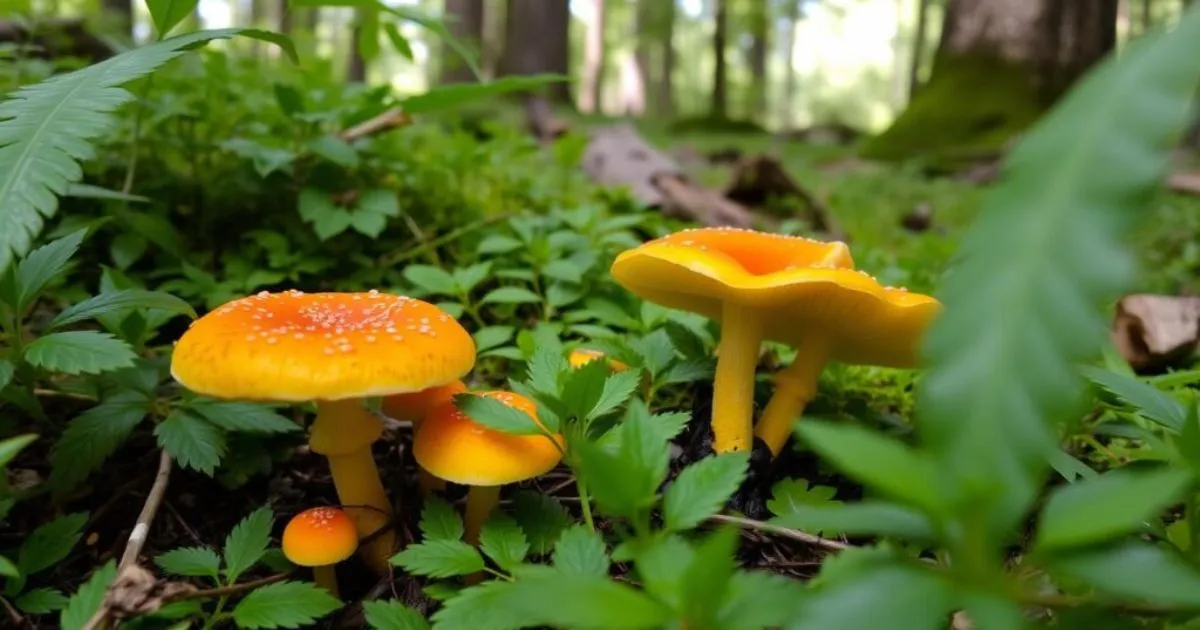Table of Contents
Chicken of the Woods Recipe
Get ready for a culinary journey with the Chicken of the Woods mushroom. This wild fungus, also known as Laetiporus, is full of flavor and health benefits. Whether you’re an experienced forager or just starting, we’ll show you how to pick, prepare, and cook these mushrooms into a delicious meal.
Key Takeaways
- Discover the unique characteristics and identification of Chicken of the Woods mushrooms
- Learn about the natural habitats and growing seasons of this versatile wild mushroom
- Explore the impressive nutritional profile and health properties of Chicken of the Woods
- Understand essential safety guidelines for foraging and handling wild mushrooms
- Master the art of selecting, cleaning, and storing your Chicken of the Woods catch
Introduction to Chicken of the Woods Mushrooms
Chicken of the woods, also known as Laetiporus, is a striking and versatile wild mushroom. It has gained popularity among foragers and culinary enthusiasts. Its vibrant orange or yellow hues and unique, fleshy texture make it a delight for the senses.
Identifying Features and Characteristics
Chicken of the woods is easily recognizable by its distinctive appearance. It grows in large, fan-shaped clusters. These clusters cling to the trunks or fallen logs of oak, beech, or hemlock trees. Its surface is smooth and velvety, with a texture that resembles tender chicken meat, hence the name “chicken of the woods.”
Natural Habitat and Growing Seasons
These captivating mushrooms thrive in temperate forests. They are found in the late summer to early fall months. They prefer damp, shaded areas and can often be spotted growing in clusters on the decaying wood of various hardwood trees. Understanding the natural habitat and growing seasons of chicken of the woods is crucial for foragers seeking to harvest these delectable fungi.
Nutritional Benefits and Health Properties
Beyond their culinary appeal, chicken of the woods mushrooms are also known for their impressive nutritional profile and potential health benefits. They are rich in protein, fiber, and a variety of essential vitamins and minerals. This makes them a healthy and valuable addition to any diet. Additionally, some studies have suggested that these mushrooms may possess anti-inflammatory and antioxidant properties. This makes them a potential ally in promoting overall well-being.
Exploring the unique characteristics, natural habitats, and nutritional value of chicken of the woods mushrooms is the first step in unlocking the gastronomic delights and potential health benefits they offer. With this knowledge in hand, you can embark on your own chicken of the woods culinary adventure.
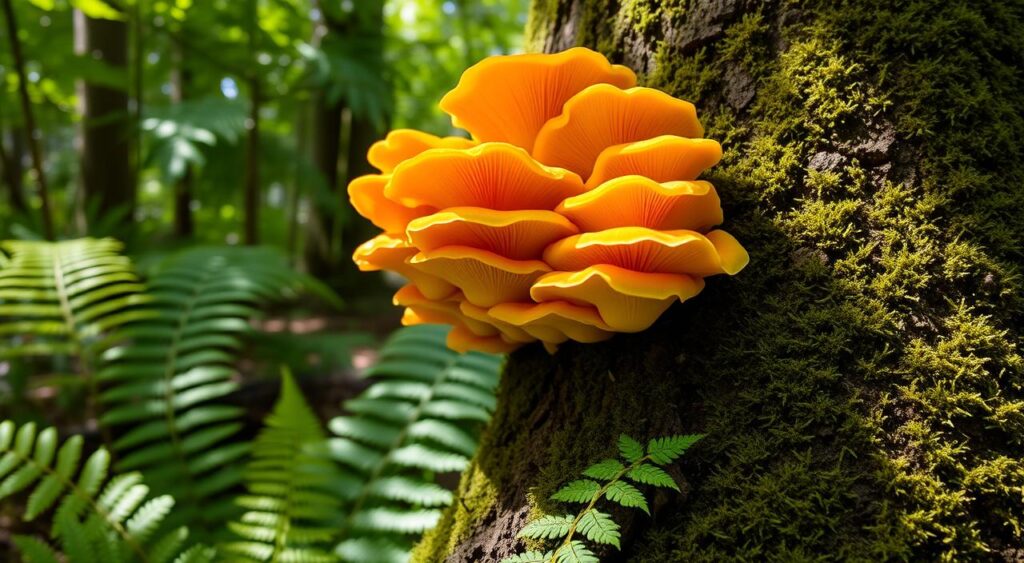
Essential Safety Guidelines for Foraging
Harvesting Chicken of the Woods mushrooms is both thrilling and gratifying. But, safety comes first. Learn these key guidelines to have a safe and fun time.
Proper Identification
Identifying mushrooms correctly is the most important step. Look for the mushroom’s orange or yellow color and fan-like shape. It should not have visible gills. Use field guides or ask experts to avoid mistakes.
Avoid Contaminated Areas
Choose safe places to forage. Stay away from polluted areas like roadsides and industrial sites. These places can have harmful chemicals.
Understand Potential Lookalikes
- The jack-o’-lantern mushroom is dangerous and can upset your stomach.
- The false chicken of the woods mushroom tastes bitter and is not good to eat.
- Know how to tell these mushrooms apart to forage safely.
| Mushroom | Identifying Characteristics | Edibility |
|---|---|---|
| Chicken of the Woods | Orange or yellow, fan-shaped, no visible gills | Edible and delicious |
| Jack-o’-lantern | Orange-brown, gills visible, grows on wood | Toxic, can cause gastrointestinal issues |
| False Chicken of the Woods (Sulfur Shelf) | Yellow to orange, fan-shaped, grows on wood | Edible but bitter and unpalatable |
By following these safety tips, you can forage for chicken of the woods mushrooms safely. Enjoy their taste while keeping your health in mind.
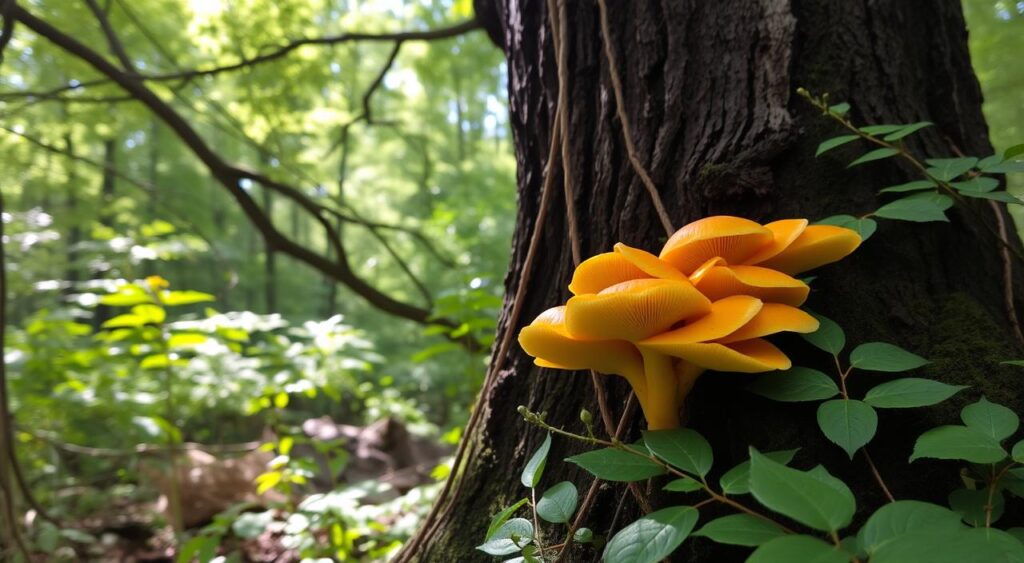
Selecting and Cleaning Your Wild Mushrooms
Preparing tasty chicken of the woods mushroom dishes starts with picking the right mushrooms and cleaning them well. Learning these steps ensures your mushrooms are fresh and ready for cooking.
How to Choose Fresh Specimens
Choose mushrooms that are firm, bright, and without blemishes. Stay away from slimy, wrinkled, or discolored ones. The best chicken of the woods have a fan-like shape and a soft, velvety texture.
Proper Cleaning Techniques
- Gently brush off dirt, debris, or insects with a soft-bristle brush or damp cloth.
- Don’t soak the mushrooms in water. It can make them soggy.
- Trim off any damaged, discolored, or tough parts to use only the best parts.
Storage Methods
Keep your cleaned mushrooms fresh by storing them in a paper or mesh bag in the fridge. Don’t use plastic bags as they trap moisture. When you’re ready to cook, just take out what you need and put the rest back in the fridge.
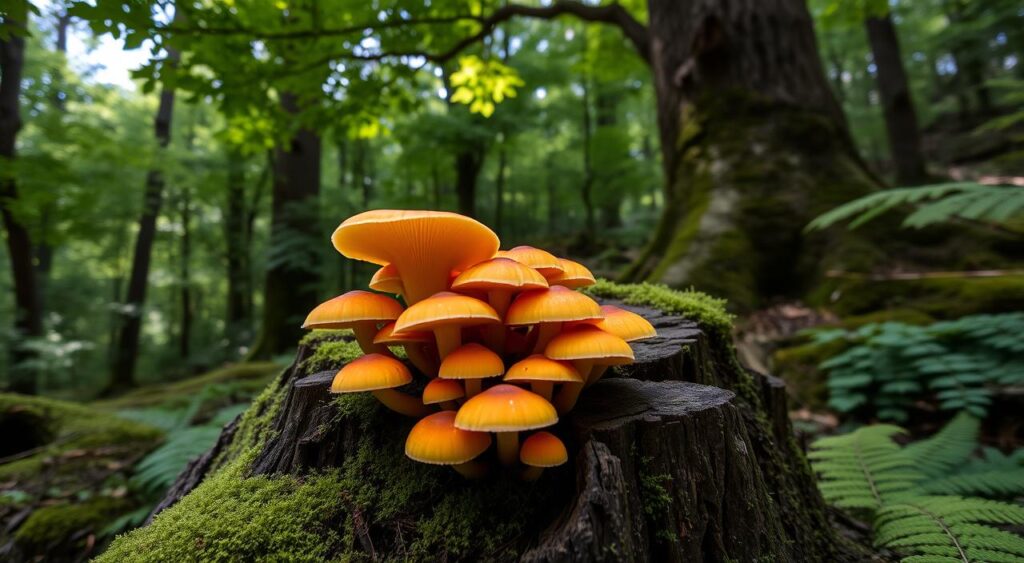
By following these tips for picking and cleaning your wild chicken of the woods mushrooms, you’re on your way to making tasty and healthy dishes.
Basic Preparation Methods Before Cooking
Enjoying chicken of the woods mushrooms starts with good prep. A few simple steps can bring out their flavor and texture before cooking.
Start by trimming the mushrooms. Cut off any tough or damaged parts. Next, cut them into uniform pieces to ensure they cook evenly.
- Trim away any woody or damaged areas
- Slice the mushrooms into even, bite-sized pieces
For more flavor, try marinating the chicken of the woods mushrooms. Combine olive oil, lemon juice, garlic, and herbs to create a flavorful marinade. It tenderizes the mushrooms and adds great smells.
| Marinade Ingredients | Quantity |
|---|---|
| Olive oil | 2 tablespoons |
| Lemon juice | 1 tablespoon |
| Minced garlic | 1 clove |
| Fresh herbs (e.g., thyme, rosemary) | 1 tablespoon, chopped |
By preparing your chicken of the woods mushrooms well, you’re on your way to a great chicken of the woods recipe.
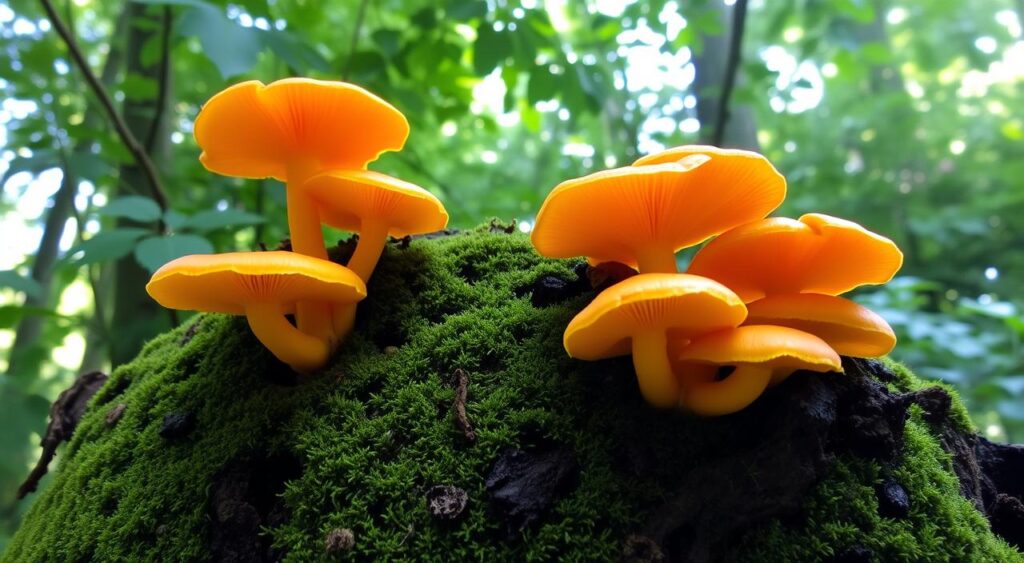
Simple Chicken of the Woods Recipe
Discover the tasty flavors of chicken of the woods mushrooms with this simple recipe. It’s perfect for both seasoned foragers and newcomers to wild mushrooms. This dish will delight your taste buds and fill you with a savory, nutritious meal.
Required Ingredients
- 1 pound of fresh Chicken of the Woods mushrooms, thoroughly cleaned and sliced
- 2 tbsp olive oil
- 2 cloves garlic, minced
- 1 tsp dried thyme
- 1/2 tsp salt
- 1/4 tsp black pepper
- Squeeze of lemon juice (optional)
Step-by-Step Cooking Instructions
- Carefully clean the chicken of the woods mushrooms, removing any dirt or debris. Slice the mushrooms into 1/2-inch thick pieces.
- Warm olive oil in a large skillet over medium heat, then stir in minced garlic and cook for 1-2 minutes until fragrant.
- Place the sliced chicken of the woods mushrooms into the skillet and cook for 5-7 minutes, stirring occasionally, until they become tender and achieve a light golden-brown color.
- Flavor the mushrooms with dried thyme, a pinch of salt, and freshly ground black pepper. Stir to combine.
- If desired, finish the dish with a squeeze of fresh lemon juice to brighten the flavors.
Cooking Tips and Timing
Don’t overcrowd the skillet when cooking the mushrooms. This helps them brown well and get a great texture. Adjust cooking time based on mushroom size and thickness. Serve warm and enjoy their earthy, savory taste.
Alternative Cooking Techniques
Chicken of the woods mushrooms can be cooked in many ways, each bringing out their special flavors and textures. You can grill, roast, or fry them for a unique taste. Each method gives a different culinary experience.
Grilling Chicken of the Woods
Grilling these mushrooms adds a smoky and charred taste. Brush them with oil and grill them on the grates. Cook for 3-5 minutes on each side, until they’re golden and crispy.
Roasting Chicken of the Woods
Roasting them in the oven enhances their earthy and nutty flavors. Toss the mushrooms with olive oil, salt, and pepper. Then, roast them at 400°F (200°C) for 15-20 minutes, flipping once. They’ll be tender and lightly caramelized.
Frying Chicken of the Woods
Frying them makes them crispy and golden. Dredge the mushroom slices in flour or breadcrumbs. Fry them in hot oil for 2-3 minutes on each side. Drain on paper towels before serving.
Try these cooking methods to find new ways to enjoy chicken of the woods mushrooms. Each technique highlights different flavors and textures, making a variety of tasty dishes.
Flavor Pairings and Complementary Ingredients
Chicken of the woods mushrooms have a unique savory taste. They pair well with many herbs, spices, and ingredients. Discover how to make this wild mushroom even more delicious.
Herbs and Spices
For the best chicken of the woods recipes, try these herbs and spices:
- Garlic – adds a robust, pungent note
- Thyme – provides an earthy, slightly minty flavor
- Rosemary – lends a fragrant, piney essence
- Sage – Offers a cozy, mildly peppery flavor.
- Smoked Paprika – Adds a gentle hint of smoky richness.
- Black pepper – enhances the savory qualities
Side Dish Suggestions
Chicken of the woods mushrooms go great with many side dishes. They match well with:
- Roasted potatoes or sweet potatoes
- Quinoa or wild rice pilaf
- Sautéed greens like kale or spinach
- Creamy polenta or grits
- Caramelized onions or roasted vegetables
Try these pairings to make your chicken of the woods recipes unforgettable. They highlight the natural beauty and taste of this wild mushroom.
Common Mistakes to Avoid
Cooking with chicken of the woods mushrooms is a fun experience. But, knowing common mistakes helps ensure your dish turns out great. Avoid these errors to enjoy a tasty and safe meal.
First, make sure you can identify the mushroom species before picking it. Chicken of the woods looks different from other mushrooms. Consuming the wrong type of mushroom can be hazardous.
- Don’t overcook the mushrooms. They should stay tender and soft. Watch the cooking time closely.
- Clean the mushrooms well before cooking. Dirt or bugs can ruin the taste and safety of your dish.
- If it’s your first time eating chicken of the woods, start with a small amount. This helps you avoid any stomach problems.
By avoiding these mistakes, you can enjoy the tasty and healthy benefits of chicken of the woods mushrooms. Have a great time cooking and eating your wild mushroom dish!
| Mistake to Avoid | Proper Approach |
|---|---|
| Misidentifying the mushroom species | Carefully inspect the mushroom’s characteristics to confirm it is chicken of the woods |
| Overcooking the mushrooms | Monitor cooking time closely to maintain a tender, succulent texture |
| Failing to clean the mushrooms thoroughly | Thoroughly clean the mushrooms to remove any dirt, debris or insects |
| Consuming large quantities for the first time | Start with small portions to gauge your personal tolerance |
“Preparing wild mushrooms demands careful attention, but the delicious results make it worthwhile. Enjoy the distinctive taste of chicken of the woods while staying aware of possible challenges.”
Advanced Recipe Variations
Elevate your chicken of the woods dishes with creative and advanced recipe variations. Explore gourmet preparations that highlight the unique texture and flavor of these wild mushrooms. These recipes are sophisticated and innovative.
Gourmet Preparations
Elevate your dish by adding chicken of the woods to elegant recipes. Try making chicken of the woods Wellington, where mushrooms are wrapped in flaky pastry. Or, make a creamy risotto with Arborio rice and Parmesan.
International Cooking Styles
Discover the versatility of chicken of the woods with international cooking styles. Use them in a fragrant Thai coconut curry or sauté with garlic, soy sauce, and ginger for a Chinese dish. For a Mediterranean taste, add them to a fluffy frittata or a savory tart.
FAQ
What are the identifying features of chicken of the woods mushrooms?
Chicken of the woods mushrooms are easily recognized by their bright orange or yellow coloration and their shelf-like or fan-shaped growth. They are typically found on hardwood trees such as oak and maple.
When and where can I find chicken of the woods mushrooms in the wild?
You can find chicken of the woods in late summer to early fall. They grow on hardwood trees, especially oak and maple. They’re common in temperate forests in North America and Europe.
What nutritional benefits do chicken of the woods mushrooms offer?
Rich in protein, fiber, and essential nutrients like vitamin C and potassium, chicken of the woods mushrooms are also low in calories and fat, making them a nutritious addition to meals.
How do I properly identify and avoid lookalike mushrooms when foraging?
Pay attention to their distinct color, shape, and growth on hardwood trees. Avoid mushrooms with a white pore surface, as they may be toxic. Only forage in areas free of contaminants and consult an expert if unsure.
How should I clean and store chicken of the woods mushrooms?
Brush off dirt and debris gently; avoid soaking them in water to prevent sogginess. Use a damp cloth or paper towel to clean them. Store in a paper bag or wrapped in a towel in the refrigerator for up to five days.
What are some tips for preparing chicken of the woods before cooking?
Trim off any tough parts before cooking. Slice or tear the mushroom into small pieces. Marinate them in olive oil, lemon juice, and herbs to tenderize and flavor them.
How can I cook chicken of the woods mushrooms?
You can sauté, grill, roast, or fry chicken of the woods. They’re great in stews and soups too. Just cook them until they’re tender and crispy.
What flavors and ingredients complement chicken of the woods mushrooms?
Chicken of the woods go well with garlic, thyme, rosemary, and paprika. They also pair with onions, tomatoes, and cheese. Try them with roasted potatoes, rice, or other starchy sides.
What are common mistakes to avoid when cooking chicken of the woods mushrooms?
Avoid overcooking to prevent toughness. Use oil or butter sparingly to avoid greasiness. Always clean and check the mushrooms for damage before cooking.

